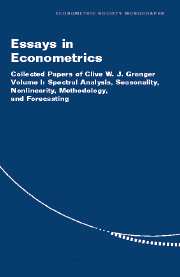Book contents
- Frontmatter
- Contents
- Acknowledgments
- List of Contributors
- Introduction
- 1 The ET Interview: Professor Clive Granger
- PART ONE SPECTRAL ANALYSIS
- 2 Spectral Analysis of New York Stock Market Prices
- 3 The Typical Spectral Shape of an Economic Variable
- PART TWO SEASONALITY
- PART THREE NONLINEARITY
- PART FOUR METHODOLOGY
- PART FIVE FORECASTING
- Index
3 - The Typical Spectral Shape of an Economic Variable
Published online by Cambridge University Press: 06 July 2010
- Frontmatter
- Contents
- Acknowledgments
- List of Contributors
- Introduction
- 1 The ET Interview: Professor Clive Granger
- PART ONE SPECTRAL ANALYSIS
- 2 Spectral Analysis of New York Stock Market Prices
- 3 The Typical Spectral Shape of an Economic Variable
- PART TWO SEASONALITY
- PART THREE NONLINEARITY
- PART FOUR METHODOLOGY
- PART FIVE FORECASTING
- Index
Summary
In recent years, a number of power spectra have been estimated from economic data and the majority have been found to be of a similar shape. A number of implications of this shape are discussed, particular attention being paid to the reality of business cycles, stability and control problems, and model building.
INTRODUCTION
During thE past four or five years a fairly large number of power spectra have been estimated using economic data. It might thus be an appropriate time to review the results obtained and to ask if the advent of spectral methods has thrown any light on the basic characteristics of economic variables. The almost unanimous result of these investigations is that the vast majority of economic variables, after removal of any trend in mean and seasonal components, have similarly shaped power spectra, the typical shape being as in Figure 3.1.
It is the purpose of this paper to illustrate this result and to discuss briefly its implications both for economic theory in general and for economic model building in particular.
It is not, of course, suggested that every economic time series produce such spectra nor that nothing else is discernable from the estimated spectra other than this simple shape. Nevertheless, the fact that such a shape arises in the majority of cases does suggest that there are certain general, overall implications for economics, and, possibly, that the estimation of power spectra alone is unlikely to be a productive technique.
- Type
- Chapter
- Information
- Essays in EconometricsCollected Papers of Clive W. J. Granger, pp. 106 - 118Publisher: Cambridge University PressPrint publication year: 2001
- 1
- Cited by

